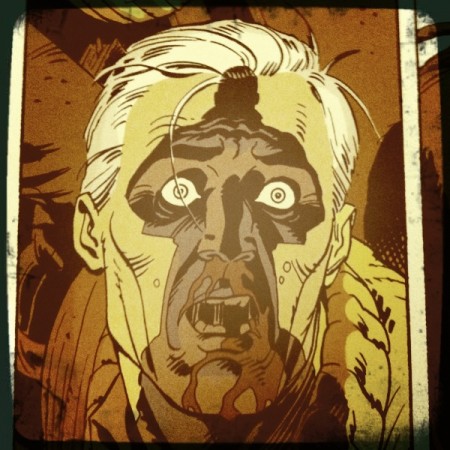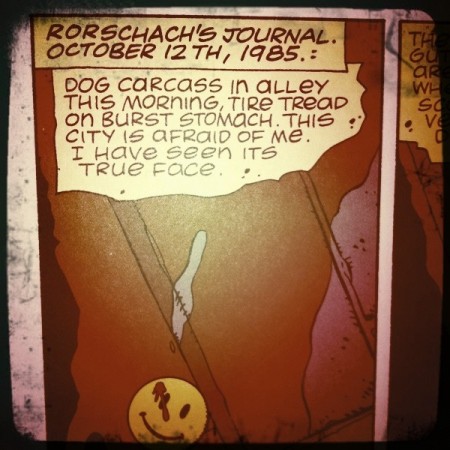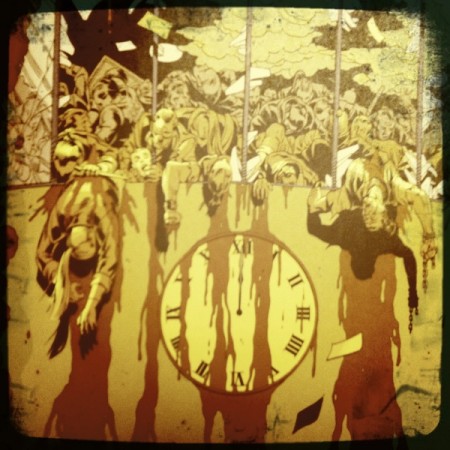OCTOBERFEAST – Watchmen
[OCTOBERFEAST is the greatest celebration of the year, a revelry dedicated to pop-culture’s most nutritious Halloween detritus. Plastic screams and artificial sweeteners have never been more bountiful. In the old country, villagers refer to the extended party as Satan’s Snacktime]
Watchmen is a lot of things. A deconstruction of the superhero archetype. An exploration of Cold War tensions. An actualization of the comics medium’s potential. One of the most meticulously-plotted, visually layered, and rewarding narrative experiences ever stuffed into paneled pages.
There’s no denyin’ that Alan Moore and Dave Gibbons created something special.
However, noticeably absent from discussions about Watchmen are any considerations as to why the creators placed the story within its given time-frame. Sure, everyone is quick to point out that this alternate history’s dark vision of 1985 conjures up all sorts of anxieties about mutually assured destruction and the necessity to avert nuclear holocaust. But the overlooked time-frame is the season in which the tale of middle-aged superheroics unfolds.
Again, it’s easy to remember that Watchmen is a lot of things – deconstruction/exploration/actualization/masterpiece – but let’s not forget that it is a metaphor for autumn itself.
The vast majority of Watchmen takes place between October 12th and November 1st – the very heart of the autumn. Although the creators could’ve used any season, staging the story during the transition from summer to winter is a subtle means of reinforcing thematic content. In essence, the happenings of Watchmen and the month in which they occur mirror one another, creating a work that deftly clues in the readers to the inevitable conclusion, even if they don’t realize it.
Perhaps the most obvious parallel to be drawn is the fact that just as Watchmen depicts (most) superheroes as run-of-the-mill folks wearing kooky costumes, Halloween is every child’s opportunity to assume a new persona. At his most heart-wrenchingly depressed, isn’t Dan Dreiberg just an overweight dude longing to play dress-up and be someone else? For every suburban youth, the wonder of Halloween, which is arguably the pinnacle of autumn, is that new roles are assumed for a single evening. Earthly weaknesses and anxieties are veiled, replaced by supernatural strengths and abilities.
Gap-toothed Tommy who pisses his pants at the first sound of thunder becomes a motherfucking ghoul. Shy Jane who lost the second grade spelling bee transforms into a goddamn ninja. Fatherless Alec who is afraid of dogs sets his sights seaward as a malevolent pirate.
This juxtaposition of inherent roles and assumed identities is fleshed out during the entire arc, but might be best illustrated in the death of Hollis Mason. While Mason’s fragile frame doesn’t stand a chance when attacked by a pack of Knot Tops, his aged mind flashes back to the days of costumed vigilantism. At this point, he can no longer invoke the Hallow’s Eve rite of transcending given form, and as such he must suffer the consequences.
More implicitly, autumn serves as a great backdrop for a story about the transition from lively to decrepit, that passage of time ushering one away from vitality and towards decay. The heroes of Watchmen are, for the most part, well past their glory days. Gone are the days of public admiration for caped crusaders, replaced by an era in which only blue gods and genius entrepreneurs are accepted with open arms. And hell, even those guys are forced to redefine their lives – Dr. Manhattan leaves the solar system and Ozymandias must reflect upon whether or not his grave deeds will successfully thwart World War III.
In short – Watchmen‘s characters are all venturing upon the October Road of their lives.
Additionally, one can also make the point that Watchmen is autumnal in the sense that it derives its true beauty in a superabundance of death. Any time that you admire the wonderful oranges and reds and yellows of New England foliage, what you’re really celebrating are the deaths of each individual leaf. Similarly. Watchmen‘s dramatic conclusion is so successful because it sees millions and millions of people dying…thereby sparing the lives of billions and billions.
In death, there is beauty.






